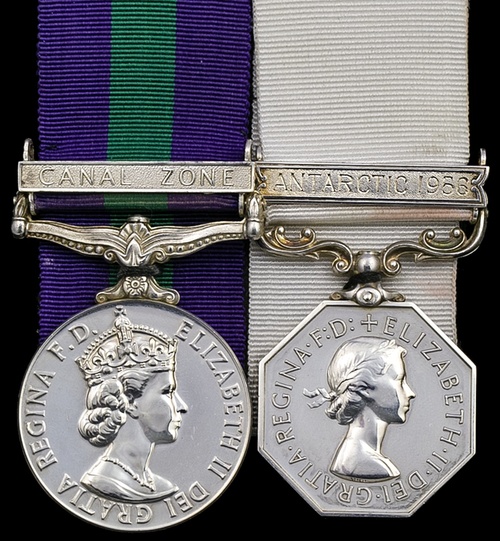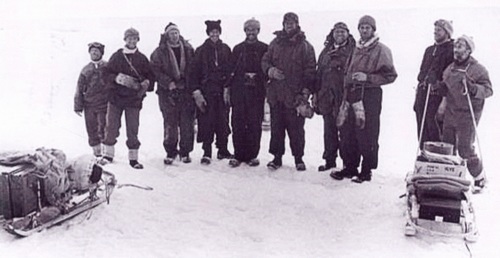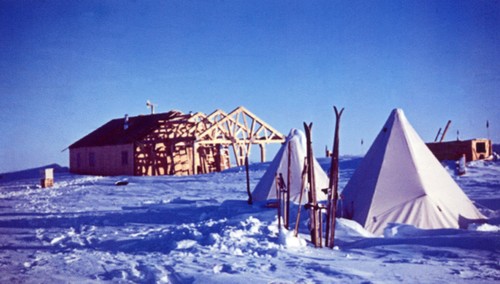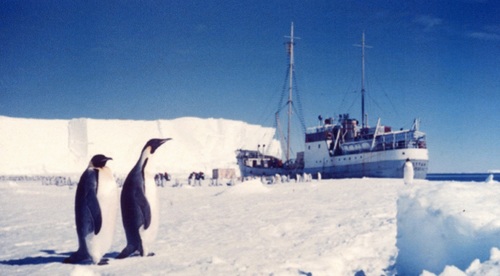Auction: 16003 - Orders, Decorations, Campaign Medals and Militaria
Lot: 93
The Fine 'Antarctic 1956' Polar Medal Pair to Captain A.R.F. Dalgliesh, The Buffs (Royal East Kent Regiment)
General Service 1918-62, E.II.R., one clasp, Canal Zone (Lt ARF Dalgliesh The Buffs); Polar Medal, one clasp, Antarctic 1956 (Angus R.F. Dalgliesh), nearly extremely fine, mounted court-style as worn (2)
Polar Medal London Gazette 28.6.1957 Angus Robin Franklin Dalgliesh
'For good services as members of the advance party of the Royal Society Antarctic Expedition for the International Geophysical Year.'
Ten silver medals with 'Antarctic 1956' clasp awarded per this edition.
Captain Angus Robin Franklin Dalgliesh, born 31.5
1928; educated at Merchant Taylors', London; commissioned Second Lieutenant, The Buffs, 21.10.1948; promoted Lieutenant, 21.10.1950; served with the regiment during the Suez Crisis, being wounded in action, receiving a 'dum-dum' through the ankle, which resulted in a sixteen week recovery; attached to the Somaliland Scouts from 27.6.1952, one of the 24 Officers of the unit; promoted Captain, 21.10.1954; later a District Officer in Kitui and later Wajir, Kenya; resigned commission, 1.7.1959; following his military career, Dalgliesh worked in the Far East for British Cellophane and in Brussels for Memorex; died, 25.12.1987, aged 59.
Halley Bay Research Station Founder
As early as 1950, the seed for a Third International Geophysical Year in 1957-58 has existed. The British plans were headed by the Royal Society, who had noted that a vast lack of overall Antarctic coverage lay in the southern area of the Weddell Sea, most particularly the Vahsel Bay region. As this region lay within the dependency of the Falkland Islands, it was strongly considered that as part of the expedition a new station, under the possession of H.M. The Queen should be established. The Treasury formally approved the advance party and the establishment of the station in a note dated 3.9.1955. Following this, Surgeon Captain David Dalgliesh, L.V.O., O.B.E., Polar Medal with two clasps, the brother of the recipient was appointed to lead the expedition. Captain Dalgliesh decided he should like to join the expedition and successfully applied to the Royal Society, joining the expedition on a wage of £420.00 per annum. His obituary states '... I was surprised, knowing his enjoyment of the hot Somaliland desert, but Robin said he would like to try a snow desert for a change.' The two brothers, together with eight other selected men and over 200 tonnes of supplied left Southampton aboard Tottan, 22.11.1955. Such was the nature of the composite Expedition party, that it was noted they were '...a cheerful bunch, mostly tradesmen' [Sir Edmund Hillary No latitude for error]. They sailed south toward the destination, although an unscheduled stop was required. The Norwegian Captain Lief Jacobsen had to be told '...it was useless to put into Falmouth for the dynamite which he had forgotten; village shops in England do not sell dynamite to foreigners.' [Dr S. Evans The Royal Society IGY Expedition to Antarctica]. Following the successful acquisition of dynamite in Rio, Tottan reached South Georgia on Christmas morning 1955. Setting out once again, the men enjoyed '...three days of effortless sailing then into really heavy pack ice at about 76½° South. Three times we were held fast and everyone was over the side with pick axes and poles...and once the Captain had to use dynamite to break us out. It was clear that at that stage we were not going to be able to penetrate that last 90 miles to Vahsel Bay so we turned back North to try to find a landing place.' [George Hemmen Halley Bay - Base Z - The background and why it is where it is]. With a number of repeated failures and a direct order to establish a station south of 75° South, the final station was established approximately 4km in from the furthest passage of Tottan, upon the Brunt Ice Shelf. Luck had struck as the Tottan was able to move into the bay ice far enough to allow unloading of the men and cargo. The date was 6.1.1956 and the station was later named after Sir Edmond Halley, to commemorate the tercentenary of his birth. In the following two weeks, the cargo was unloaded to the selected site, before the Tottan left, 23.1.1956 before the ice closed in. Once the ship had left, the main aim for Expedition was the building of shelter. This took five weeks, meaning sleeping in tents and working shifts of 15 hours until the Main Hut was erected, being 130ft x 27ft. Such was the speed of work of the men that the kitchen became operational, 21.2.1956, the men moved from tentage into the partially completed hut, 26.2.1956, the Post Office first day cover was official, 29.2.1956 and the outer shell was fully weatherproofed and completed 31.3.1956. Soon after the first communications and scientific experiments were completed, with contact made with Port Stanley and the first meteorological observations being made from the 12m high observation tower [ibid]. In all the Advance Expedition in 1956 was a success with all objectives fulfilled, with the Tottan being first in relieving the men of the station in January 1957, in bringing the forward party for the 1957-58 Expedition. All the men were returned to London, March 1957.
Such was the success of the Advance Party in 1956 that the British Antarctic Survey retains a station at Halley Bay to this day. The Halley VI Research Station was completed and opened, 5.2.2013. The original Hut and Station, built by Dalgliesh and the Advance Party of 1956 was used for many years after their departure. Halley V Research Station detected the hole in the ozone layer using the Dobson spectrophotometer, 1985.
89 General Service Medals 1918-62 with clasp Canal Zone awarded to The Buffs.
Subject to 20% VAT on Buyer’s Premium. For more information please view Terms and Conditions for Buyers.
Sold for
£6,500











